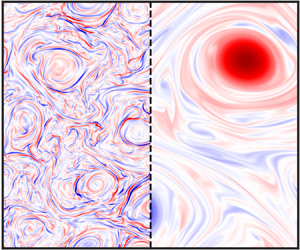Article contents
Two-dimensional partially ionized magnetohydrodynamic turbulence
Published online by Cambridge University Press: 11 August 2020
Abstract

Ionization occurs in the upper atmospheres of hot Jupiters and in the interiors of gas giant planets, leading to magnetohydrodynamic (MHD) effects that couple the momentum and the magnetic field, thereby significantly altering the dynamics. In regions of moderate temperatures, the gas is only partially ionized, which also leads to interactions with neutral molecules. To explore the turbulent dynamics of these regions, we utilize partially ionized magnetohydrodynamics (PIMHD), a two-fluid model – one neutral and one ionized – coupled by a collision term proportional to the difference in velocities. Motivated by planetary settings where rotation constrains the large-scale motions to be mostly two-dimensional, we perform a suite of simulations to examine the parameter space of two-dimensional PIMHD turbulence and pay particular attention to collisions and their role in the dynamics, dissipation and energy exchange between the two species. We arrive at, and numerically confirm, an expression for the energy loss due to collisions in both the weakly and strongly collisional limits, and show that, in the latter limit, the neutral fluid couples to the ions and behaves as an MHD fluid. Finally, we discuss some implications of our findings to current understanding of gas giant planet atmospheres.
- Type
- JFM Papers
- Information
- Copyright
- © The Author(s), 2020. Published by Cambridge University Press
References
REFERENCES
- 3
- Cited by




